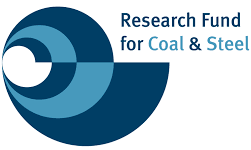{{serverconnectlatestnews.data.showlatestnews.data[0].news_title}}
{{serverconnectlatestnews.data.showlatestnews.data[0].news_date.formatDate("d MMM yyyy")}}
{{serverconnectlatestnews.data.showlatestnews.data[0].news_teaser}}

Precipitation of Micro Alloy Particles in B and Mn alloyed steel grades and their Interaction between elements, segregation, and defects during continuous casting.



The project has received funding from the Research Fund for Coal and Steel under grant agreement No. 800644
Micro-alloyed steel grades represent 80% of the total production by European engineering steel mills. In parallel, European producers are working on next generation AHSS concepts with high Mn contents. Both classes of steels present many industrial problems related to solidification and cooling in the continuous casting (CC) process.
The overall objective of the PMAPIA project is to reduce yield loss and requirements for surface repair due to cracking defects in CC semis by optimisation of micro alloying, steel composition, and casting parameters. In engineering steels, B and S are added to micro-alloyed steels to increase hardenability and machinability, respectively. The earlier PMAP project (RFSR‐CT‐2012‐00008) showed that B and S are responsible for micro-segregation, increasing the risk of cracking. S reduces hot ductility whereas B increases the sensitivity to cracking during tertiary cooling. Preventing B precipitation as BN markedly improves hot ductility. PMAP showed that Mn additions counteract the negative effect of S, however high Mn content degrades hot ductility. This is a problem in higher Mn steels. It was shown that MnS secondary precipitation impairs hot ductility. These findings opened new lines of investigation for making a step improvement in the cracking problems in these steels.
PMAPIA aims to alleviate B micro-segregation induced cracking by defining the interaction between B, S, Mn, and other elements. B and S compete at austenite grain boundaries, and their interaction needs to be quantified, as B is able to counteract grain boundary decohesion, meaning B can potentially have both negative and positive effects on cracking resistance. The project will perform laboratory and pilot scale investigation followed by in-field validation of the mechanisms of interaction between elements, their segregation, and cracking. The results of this validation will be new guidelines for safe industrial casting practices for these steels.
Dates - 1st June 2018 – 31st March 2022
Sponsor - EU Research Fund for Coal and Steel (RFCS)
EU Contribution - €1,236,697
Overall Budget - €2,061,162
Swerea KIMAB AB (Sweden) – Coordinator
Materials Processing Institute (United Kingdom)
Sidenor Investigacion Y Desarrollosa (Spain)
Rheinisch-Westfaelische Technische Hochschule Aachen (Germany)
Voestalpine Stahl GmbH (Austria)